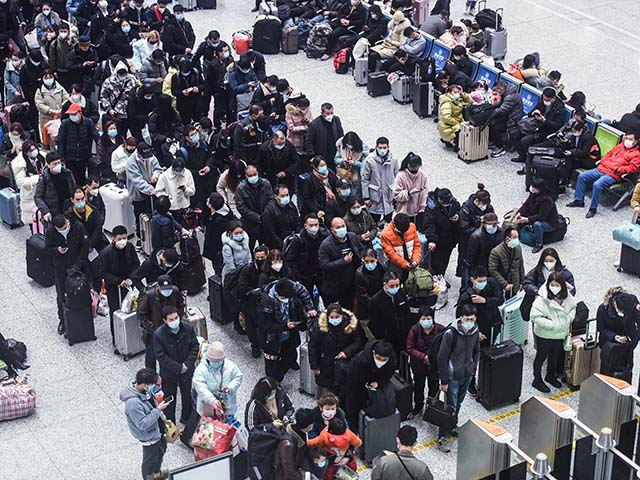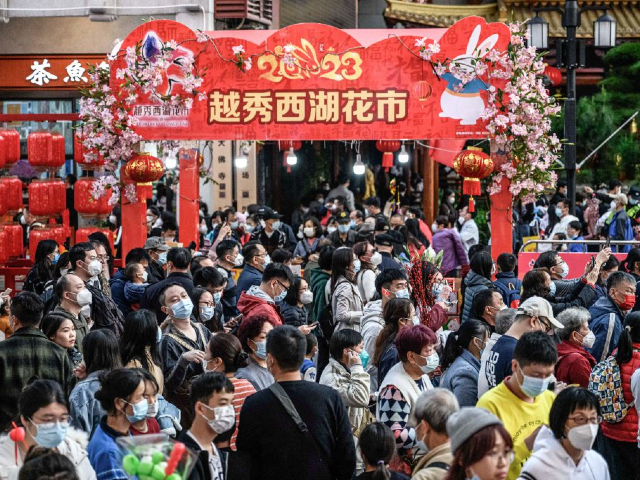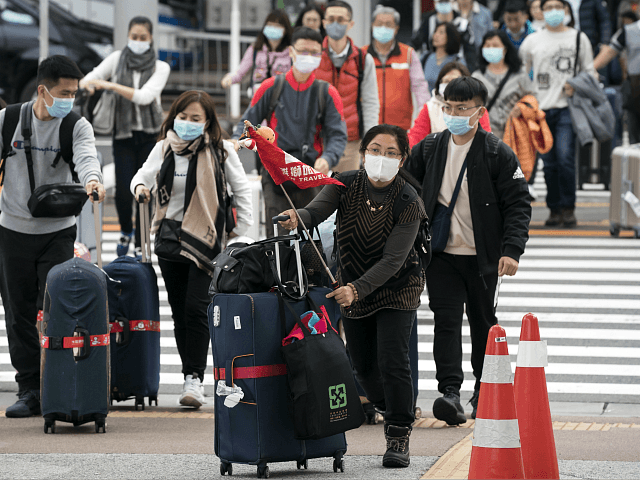The Chinese National Health Commission (NHC) warned during a press conference on Thursday the “explosive surge” in travel expected for the Lunar New Year in February will result in elevated levels of Wuhan coronavirus infection and, potentially, an increase in “the risk of severe illness and death.”
The warning followed nearly two months of reports of major Chinese cities experiencing overcrowding in hospitals as children succumbed to a variety of respiratory diseases, including coronavirus, influenza, and mycoplasma pneumoniae, a bacterial infection. Chinese doctors commonly address these infections – most of which are viral – with antibacterial IVs requiring hospitalization. As a result, hospitals attracted such large numbers of children that some set up “homework stations” for children to continue to work as they received their IVs.
The Chinese government insisted that the infections were caused by known pathogens, including Wuhan coronavirus, influenza, adenovirus, and others. Officials suggested that the unusual outbreak of disease was in part exacerbated by dictator Xi Jinping’s “zero-covid” policy, which for two years forced citizens into alternating states of house arrest and imprisonment in tortuous and unsanitary quarantine camps. Lockdowns and house arrest deprived the public, particularly children born during the lockdowns, of normal exposure to pathogens, which helps build up humans’ immune system, Chinese state media suggested.
As of Monday, Chinese public health officials claimed the number of documented respiratory infections in the country had been in a pattern of slow decline. The NHC suggested on Thursday, however, that the pattern may not hold as millions of Chinese are expected to travel around the world for Lunar New Year, traditionally China’s largest and most important holiday.
The state-run Global Times newspaper reported that NHC officials were especially concerned with the JN.1 variant of Wuhan coronavirus. As of Tuesday, JN.1 is believed to represent 44 percent of all known coronavirus infections globally. Health experts consider the variant – as many of its predecessors – more contagious than prior iternations but potentially less capable of causing severe disease.

Passengers crowd Hangzhou East Railway Station during the peak travel period ahead of the Lunar New Year, which welcomes the Year of the Tiger on February 1, in the city of Hangzhou in China’s eastern Zhejiang province on January 29, 2022. (STR/AFP via Getty Images)
“CDC projects that the variant JN.1 comprises an estimated 15–29% of in the United States as of December 8, 2023,” the U.S. Centers for Disease Control (CDC) advised on December 8. “CDC projects that JN.1 will continue to increase as a proportion of SARS-CoV-2 genomic sequences. It is currently the fastest-growing variant in the United States.”
The CDC noted that scientists have not reached concrete conclusions on whether JN.1 causes the exact same symptoms as prior variants. Some reports indicate that JN.1 is slightly more likely to cause gastrointestinal problems rather than only respiratory symptoms.
In China, the NHC said on Thursday that it believes JN.1 has the potential to become the dominant variant of Wuhan coronavirus in the country, particularly after the return of travelers for the Lunar New Year.
“The JN.1 variant may develop into the dominant strain in China due to factors such as its continuous transfer from abroad and the movement of people before and after the Spring Festival, contributing to the increase in [Wuhan coronavirus] cases and increasing the risk of severe illness and death among vulnerable populations,” the Global Times cited NHC officials as stating.
The officials warned the public to expect “a trend of alternating or simultaneous outbreaks of various respiratory diseases … with the approach of the New Year’s Day holidays and the Spring Festival travel rush.”
NHC officials urged the public to engage in “social distancing” to avoid disease.
The Global Times reported an increase in the number of confirmed respiratory infections in the past week in China – a contrast to the People’s Daily, the official newspaper of the Chinese Communist Party, boasting on Monday that respiratory infections had “reached their lowest level since the beginning of 2023.”
“While influenza activity has slightly decreased but still remains high, infections of mycoplasma pneumoniae, adenovirus, and respiratory syncytial virus rose and fell. [Wuhan coronavirus] activity is at its lowest level this year, according to China CDC,” the People’s Daily reported.
Lunar New Year is scheduled to take place this year on February 10. It is the first following a full year without “zero-covid,” the lockdown and quarantine camp policy, which may result in record numbers of travelers taking advantage of their newfound freedom.

People visit a traditional Spring Festival flower market which reopens after closure due to the spread of the Covid-19 coronavirus in Guangzhou, in China’s southern Guangdong province (Photo by STR/AFP via Getty Images)
The Global Times described an “explosive surge” in travel, hotel, and other vacation bookings outside of the country in the past week for the Lunar New Year holiday. Chinese tourists were reportedly especially interested in snowy retreats for skiiing and other winters sports: “A number of new trends have been observed in this year’s winter outbound travels, thanks to the growing enthusiasm among Chinese people for skiing and hot springs, as well as for concerts and music festivals.”
The Chinese Foreign Ministry appeared to give its blessing for global celebrations of Lunar New Year in remarks on Monday celebrating the United Nations adding the holiday to its “floating holiday” calendar, which allows for minimal scheduling of work events.
“The festival embodies the core values of harmony, love and peace in Chinese culture. We look forward to celebrating the Spring Festival with the world,” Chinese Foreign Ministry spokeswoman Mao Ning told reporters.
The 2020 Lunar New Year was the event that elevated the Wuhan coronavirus outbreak of 2019 from a localized health emergency to a pandemic killing an estimated 7 million people. The city of Wuhan allowed 5 million people to leave for the Lunar New Year holiday before instituting a lockdown; local officials organized mass gatherings in January 2020 to celebrate the holiday despite having knowledge of an infectious disease spreading. The most egregious of these events was a Lunar New Year banquet for 130,000 people, an attempt to break the world record for largest banquet.

COMMENTS
Please let us know if you're having issues with commenting.